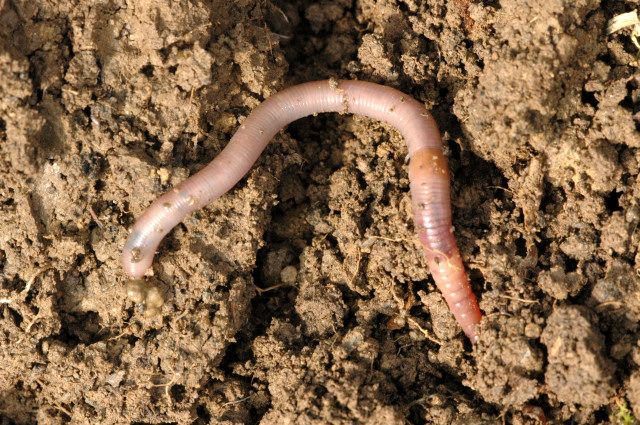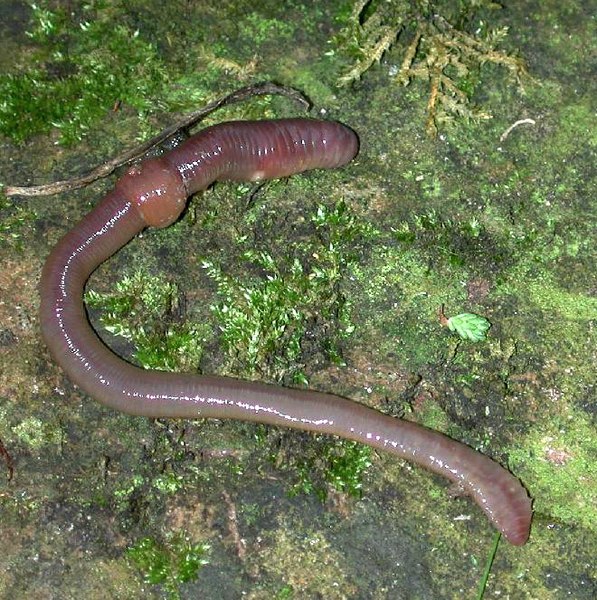All Hail The Conquering King: The Unstoppable Earthworm
There are no earthworms native to the Northeastern United States or the upper Midwest. They were all wiped out in the last Ice Age around 10,000 years ago. (A giant mountain of ice crushing your home might cause you problems too.) These days, though, earthworms are to be found all over the region, and it's because we brought them.

Lumbricus terrestis [Image source]
More specifically, John Rolfe brought them. Yes, John Wolfe, husband of Pocahontas. In the early 1610s, Rolfe was instrumental in introducing the stronger Caribbean strain of tobacco into the Jamestown colony. Tobacco quickly became by far their most important export. When English ships arrived to purchase tobacco, they offloaded ballast to even out the weight. That ballast consisted of stones and dirt from England, which contained English earthworms. Other earthworms from around the world were also brought over in the root balls of plants in the horticultural trade.
The troubles of Jamestown are well documented- three out of every four early Jamestown colonists died. The massive amounts of tobacco they planted destroyed the soil- few plants are as lethal to soil as tobacco. But it was the plants, animals, and diseases that they introduced that really changed the face of North America. Bees, for instance, are responsible for allowing European plants to prosper. Most pollinating insects just have a few flowers they prefer. The European honeybee, however, will pollinate any flower it comes across. This transfer of invasive species across the Atlantic became known as the Colombian Exchange.
Let's get back to our little burrowing earthworm friends, though. You've probably heard that they're great for gardens- and most of the time, they are. It turns out, however, that they're actually quite bad for North American native forests.

Eastern deciduous forest. [Image source]
Current research is indicating that they're damaging native North American ecosystems, especially temperate forests, in several ways. The trees, shrubs, and other plants of North American temperate forests evolved to gain their nutrients from thick layers of decaying organic detritus- leaves, twigs, etc. Earthworms get to those nutrients first, converting them into soil quicker, allowing those nutrients to be leached out of the soil by rain and groundwater movement faster than they normally would be. Young plants with shallow roots then have more trouble taking off. This has had the effect of lowering the biodiversity of American temperate forests. The loss of the thick organic detritus layer can also make the soil more vulnerable to erosion. On top of that, they're releasing not insignificant amounts of carbon into the air!
There's not a lot that can be done to slow the spread of earthworms- they're underground, so you can't really poison them without poisoning the land. They certainly can't be hunted, and nothing hunts them in large enough numbers to control their populations. When you see an earthworm in North America, you're almost certainly seeing an invasive European or Asian earthworm- the native ones are rarely seen. The best strategies we've found it attempting to prevent fishermen from using them as bait and removing invasive shrubs whose root systems they enjoy.
Invasive species are often overlooked in favor of bigger, flashier environmental problems like climate change, deforestation, and pollution. They're by far one of the most damaging and lasting problems we've caused on the planet, however. There are countless examples of invasive species we've introduced wrecking environments. Housecats driving songbird species extinct. Rabbits wreaking havoc across Australia. Zebra mussels in the Great Lakes. Rats eating lizard eggs. Unlike many other environmental problems, where the damage we produce is a direct result of our actions, once an invasive species takes hold, it self-perpetuates. The problem just starts snowballing until it's out of control.
When thinking about environmental issues like invasive species, however, it's extremely important to remember that no environmental issues exist in a vacuum. They all interrelate and effect one another. Earthworms are producing more atmospheric carbon dioxide, exacerbating climate change- which, in turn, extends the area in which earthworms can comfortably survive. We have to address environmental problems both specifically and as part of a cohesive, interrelating system. Our civilization does not exist separately from nature. Even the most concrete-locked city dweller is inextricably a part of the global ecosystem. We will not survive unless we stop acting like we're above the natural world.
Bibliography:
http://charlesmann.org/articles/NatGeo-Jamestown-05-07-1.htm
https://en.wikipedia.org/wiki/Invasive_earthworms_of_North_America
http://www.npr.org/templates/story/story.php?storyId=9105956

You've received a FULL upvote from #TheUnmentionables - a SteemIt community full of members who like to kick ass, take names, and occasionally do it wearing (or forgetting to wear) our unmentionables...
Please upvote this comment so we can help our members grow faster!
I did not know that worms were invasive and potentially destructive, but I'm not surprised. The south-western US lost maybe as much as 75% of its pinon trees not long ago to a bark beetle. The beetle came from Asia in timber imports and took up residence in our trees. Then came a several year drought, which happens from time to time in deserts, and the weakened trees were consumed by their occupants. Just one more of many ways we've screwed things up.
Yep! Stuff like this is common place now!
Are you referring to the Ash Borer, or...?
I don't know. Everyone just calls it a bark beetle.
Congratulations! Your post has been curated by the @steemstem team and has been featured on SteemStem Distilled #3:
https://steemit.com/steemstem/@steemstem/steemstem-distilled-3
Awesome, thanks!
:*
Isabella Rossellini once said:
Animals are everywhere. Some are more romantic, like tigers and elephants and chimpanzees, and some are less romantic, like earthworms, but they are just as interesting.
I had no idea earthworms weren't natural to north america! Back when I worked at the San Francisco Zoo, we talked about invasive species quite a bit - but we focused on the big case studies like Cane Toads in Australia, for example. The intent was to try and convince Californians to not get ferrets and hedgehogs as pets (as they're not native to the state). The biggest thing I learned: people don't care, despite being educated. Hopefully that attitude changes before it's REALLY too late...
There is actually active resistance to the concept in places- I know of at least one book claiming invasive plant species are a good thing. It's absurd, but it's there.
whaat!! ack!
Well actually not that surprised.. I mean the whole cane toad debacle in Australia was instigated because it was initially successful in Puerto Rico - the cane bugs were introduced to take care of the beetles and it worked in that cirucumstance. I don't know what the state of Cane Toads are now there, though.
Regardless, it might work in one place, probably as a fluke, but one instance shouldn't be the reasoning for doing it everywhere. :/ oy vey
Every single ecosystem is unique, and a species that fits just fine in one locale might die out in another and take over in a third!
Indeed!!
I used to catch earthworms to use them as bait for fishing. These little fellas do huge stuff to the ecosystem.
It's probably okay to use them for bait, so long as you don't then release the unused earthworms in an area without earthworms.
Also, I haven't been fishing in over a decade, I need to go again.
Fishes love 'em. :D
I don;'t fully agree with your conclusion:
Isn't it already too late? IMO, yes!
Even if it is actually too late for us to survive, we can't know for sure- and even if we could, it's a sucker bet to not try and survive. No species lasts forever, but every year you eke out is a win. On top of that, many of the best survival strategies for us now involve treating our environment better, so it's a win for the planet as well.
Sure we should try. I agree with this, but human beings seem to be on the wrong slope at the moment :p But we should try to make the world better. At least, some of us will be able to say: 'I have tried'. Failing is not a problem, but not trying is :)
I used to keep earthworm with chicken shit and some unfertile earth. After just a few days the earth worm will transform the earth into the healthiest and most fertile base for any plant. Dont underestimate these creatures.
Much of the problem comes from WHERE the earthworms are doing their work. In a compost pile, or in some compacted earth and chicken shit? They'll do wonders. In the middle of a temperate forest that has a carefully established natural balance? They're going to be a real problem. It's all about context.
Should I find some earth worms for my chopped veges and banana peals @perennial?
wow who would have thought they are so bad for the US. i know about some plants that have invaded russian forests from the US and grew extremely huge there. but never thought earthworms could make it so bad!
Invasive species are a huge problem globally- species that never evolved to deal eith one another are being forced into conflict.
This little earthworm is important work to do, digests the soil.
Depends on where they're doing it at! In your garden, no problem. In delicate forest ecosystems they're foreign to? Not so good of a situation.